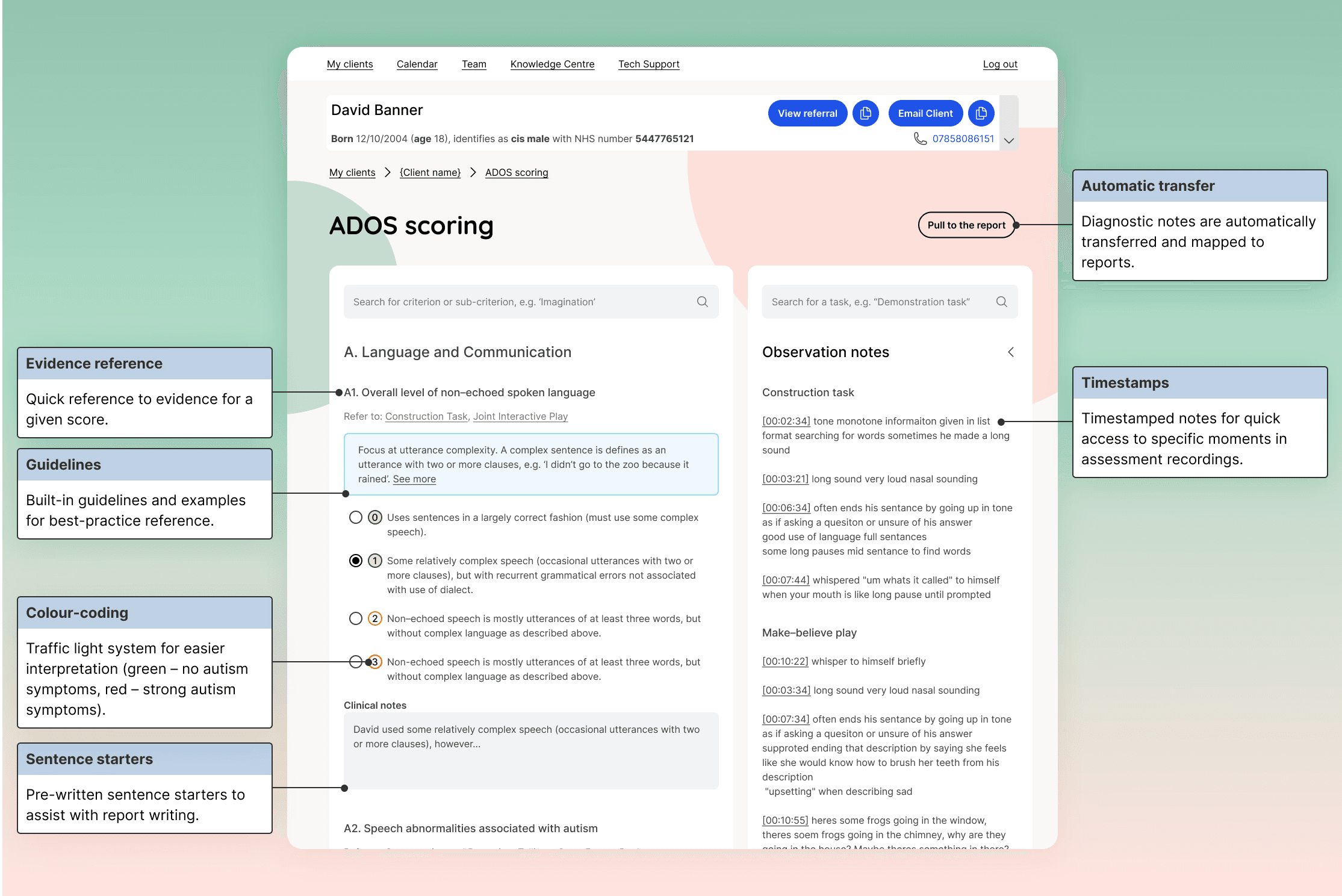Streamlined autism assessment
Design is strategic
When I joined, the company was transitioning from a fast-paced, survival-mode startup to a more stable scale-up with secured investment and a growing team. While operational leadership valued design, there was still a learning curve around what it truly meant to be a design-driven company. The vision felt unclear at times, and the roadmap was often reactive, shaped largely by design and tech debt.
I wanted my work to be purposeful and strategic. Without proper research, I risked missing the real problems. But how could I know without understanding the bigger picture?
To make real progress, I needed to understand all three perspectives: operational leadership, clinicians, and clients.
Business perspective
First, design needs to be informed by the business. I met with operational leadership—product, tech, and clinical directors—one-on-one to understand their vision and biggest pain points. While their views varied, one theme was clear:
The company's primary revenue stream came from NHS contracts for autism assessments—not post-assessment therapy—which conflicted with their broader vision of becoming a holistic mental health provider.
Clinical team perspective
One of the first practices I introduced was setting up a research repository with a steady stream of clinical feedback. Regular “coffee chats” with the clinical team and FullStory tracking helped me gather insights into their everyday work.
This was broad, exploratory research focused on gathering insights into their everyday work. But above all, it was about building trust and relationships with the internal team who were at the core of the company.
One issue really stood out, appearing in almost all of my conversations. The UI flow for conducting assessments was built in a rush when the company unexpectedly pivoted from behavioural therapy to autism assessments—two very different areas of mental health with entirely different processes. As a result, both the clinical and client experiences were clunky, but the bigger issue was that clinicians were heavily relying on spreadsheets to collect diagnostic evidence and score it against autism assessment questionnaires to reach a diagnosis.
As a product designer, I always pay attention to the makeshift tools people create to solve their problems. These workarounds are often powerful, well-thought-out solutions limited by the technology.
Clients’ perspectives
The last piece was understanding the client and their family perspectives. Better product experiences come from truly understanding your users. We sent out email invitations for interviews, highlighting the value of their feedback, and, with family permission, I observed assessments. I went through the process myself, simulating the young adult autism assessment journey.
The family’s feedback overlapped with the leadership’s concerns—while they appreciated the diagnosis, they were now stuck in another lengthy queue, sometimes lasting a year or more, waiting for post-diagnostic therapy.
Design is informed
As a designer, if you understand the problem, you can adapt the tools to deliver the right solution in the solution discovery. But without a clear problem to solve, all you’re creating are nice-looking artifacts.
There’s a quote I really love:
“If I had an hour to solve a problem, I’d spend 55 minutes thinking about the problem and 5 minutes thinking about solutions.”
…and I couldn't agree more.
Autism assessments were the company’s bread and butter, but we couldn’t build a holistic mental health provider vision on shaky foundations. Streamlining autism assessments by integrating clinical spreadsheets into product features was a practical first step. The goal was to free up clinicians’ time spent managing spreadsheets and redirect it towards extra post-diagnostic family sessions.
It was a win across the board:
For the business: Improving service quality and enabling the company to charge more for contracts, which directly tied to the KPI of improving clinician efficiency.
For clients: Providing more support to families who felt “left with the report and didn’t know what to do next,” taking a small but important step towards the vision of a holistic mental health provider.
For clinicians: Boosting job satisfaction by allowing them to focus on meaningful feedback sessions instead of wrestling with spreadsheets.
Design is collaborative
Once the idea made it onto the product roadmap, I conducted focused problem discovery through clinician shadowing and interviews, transforming insights into service blueprint and user journey to highlight key issues. I then led solution discovery with my engineering team.
Keeping the engineering team involved without overwhelming is essential. Design is a team sport.
It saves time later—they have a much better understanding of what’s going on, and they often contribute insightful solutions. To keep everyone engaged and aligned, facilitated problem statement and idea sketching workshops. Based on these, I created wireframes, which were refined through usability tests with clinicians.
Design is impactful
The solution consisted of three parts:
Note-taking system to integrate evidence collection into live sessions.
Automated evidence organization and mapping to diagnostic tools.
Automated report creation based on processed evidence.
After launching to 340 clinicians, evidence collection time was reduced by 20 minutes per session over 3 months. A few months later, the company introduced 15-minute longer feedback sessions, renegotiating assessment value with NHS trusts by 2-4%. 🎉



